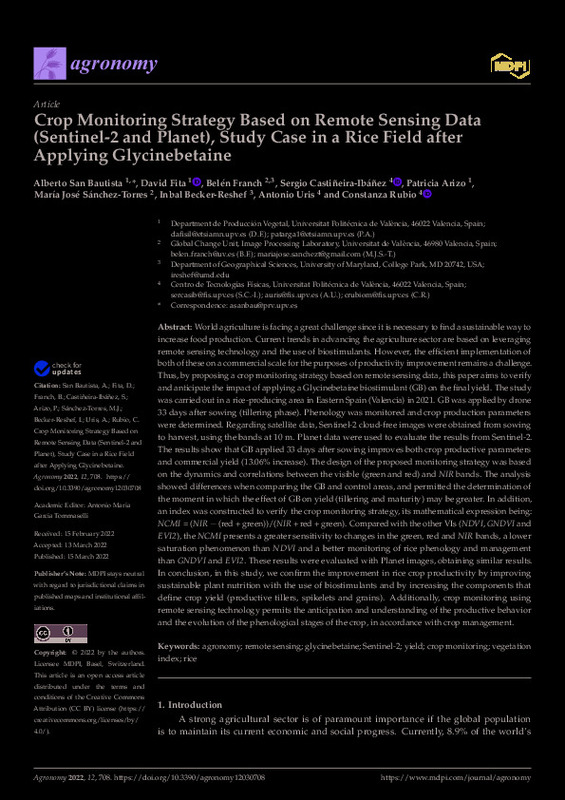JavaScript is disabled for your browser. Some features of this site may not work without it.
Buscar en RiuNet
Listar
Mi cuenta
Estadísticas
Ayuda RiuNet
Admin. UPV
Crop Monitoring Strategy Based on Remote Sensing Data (Sentinel-2 and Planet), Study Case in a Rice Field after Applying Glycinebetaine
Mostrar el registro completo del ítem
San Bautista Primo, A.; Fita-Silvestre, D.; Franch, B.; Castiñeira Ibáñez, S.; Arizo, P.; Sánchez-Torres, MJ.; Becker-Reshef, I.... (2022). Crop Monitoring Strategy Based on Remote Sensing Data (Sentinel-2 and Planet), Study Case in a Rice Field after Applying Glycinebetaine. Agronomy. 12(3):1-23. https://doi.org/10.3390/agronomy12030708
Por favor, use este identificador para citar o enlazar este ítem: http://hdl.handle.net/10251/198811
Ficheros en el ítem
Metadatos del ítem
| Título: | Crop Monitoring Strategy Based on Remote Sensing Data (Sentinel-2 and Planet), Study Case in a Rice Field after Applying Glycinebetaine | |
| Autor: | Franch, Belen Sánchez-Torres, María José Becker-Reshef, Inbal | |
| Entidad UPV: |
|
|
| Fecha difusión: |
|
|
| Resumen: |
[EN] World agriculture is facing a great challenge since it is necessary to find a sustainable way to increase food production. Current trends in advancing the agriculture sector are based on leveraging remote sensing ...[+]
|
|
| Palabras clave: |
|
|
| Derechos de uso: | Reconocimiento (by) | |
| Fuente: |
|
|
| DOI: |
|
|
| Editorial: |
|
|
| Versión del editor: | https://doi.org/10.3390/agronomy12030708 | |
| Coste APC: |
|
|
| Código del Proyecto: |
|
|
| Agradecimientos: |
|
|
| Tipo: |
|









